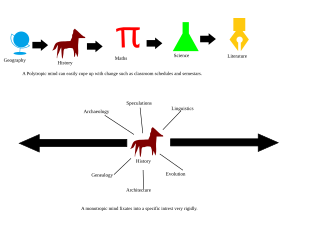
A mental disorder is an impairment of the mind disrupting normal thinking, feeling, mood, behavior, or social interactions, and accompanied by significant distress or dysfunction. The causes of mental disorders are very complex and vary depending on the particular disorder and the individual. Although the causes of most mental disorders are not fully understood, researchers have identified a variety of biological, psychological, and environmental factors that can contribute to the development or progression of mental disorders. Most mental disorders result in a combination of several different factors rather than just a single factor.

Attention deficit hyperactivity disorder (ADHD) is a neurodevelopmental disorder characterized by executive dysfunction occasioning symptoms of inattention, hyperactivity, impulsivity and emotional dysregulation that are excessive and pervasive, impairing in multiple contexts, and developmentally-inappropriate.

Methylphenidate, sold under the brand names Ritalin and Concerta among others, is a central nervous system (CNS) stimulant used medically to treat attention deficit hyperactivity disorder (ADHD) and, to a lesser extent, narcolepsy. It is a first-line treatment for ADHD ; it may be taken by mouth or applied to the skin, and different formulations have varying durations of effect. For ADHD, the effectiveness of methylphenidate is comparable to atomoxetine but modestly lower than amphetamines, alleviating the executive functioning deficits of sustained attention, inhibition, working memory, reaction time and emotional self-regulation.

Atomoxetine, sold under the brand name Strattera among others, is a selective norepinephrine reuptake inhibitor (sNRI) medication used to treat attention deficit hyperactivity disorder (ADHD) and, to a lesser extent, cognitive disengagement syndrome (CDS). It may be used alone or along with stimulant medication. It enhances the executive functions of self-motivation, sustained attention, inhibition, working memory, reaction time, and emotional self-regulation. Use of atomoxetine is only recommended for those who are at least six years old. It is taken orally. The effectiveness of atomoxetine is comparable to the commonly prescribed stimulant medication methylphenidate.

Hyperfocus is an intense form of mental concentration or visualization that focuses consciousness on a subject, topic, or task. In some individuals, various subjects or topics may also include daydreams, concepts, fiction, the imagination, and other objects of the mind. Hyperfocus on a certain subject can cause side-tracking away from assigned or important tasks.
Adult Attention Deficit Hyperactivity Disorder is the persistence of attention deficit hyperactivity disorder (ADHD) into adulthood. It is a neurodevelopmental disorder, meaning impairing symptoms must have been present in childhood, except for when ADHD occurs after traumatic brain injury. Specifically, multiple symptoms must be present before the age of 12, according to DSM-5 diagnostic criteria. The cutoff age of 12 is a change from the previous requirement of symptom onset, which was before the age of 7 in the DSM-IV. This was done to add flexibility in the diagnosis of adults. ADHD was previously thought to be a childhood disorder that improved with age, but recent research has disproved this. Approximately two-thirds of childhood cases of ADHD continue into adulthood, with varying degrees of symptom severity that change over time and continue to affect individuals with symptoms ranging from minor inconveniences to impairments in daily functioning.
The hunter versus farmer hypothesis is a proposed explanation for the nature of attention-deficit hyperactivity disorder (ADHD). It was first suggested by radio host Thom Hartmann in his book Attention Deficit Disorder: A Different Perception.
Cognitive disengagement syndrome (CDS) is a syndrome characterized by developmentally-inappropriate, impairing and persistent levels of decoupled attentional processing from the ongoing external context and resultant hypoactivity. Symptoms often manifest in difficulties with staring, mind blanking, absent-mindedness, mental confusion, and maladaptive mind-wandering alongside delayed, sedentary or slow motor movements. To scientists in the field, it has reached the threshold of evidence and recognition as a distinct syndrome.
Neurodevelopmental disorders are a group of mental conditions affecting the development of the nervous system, which includes the brain and spinal cord. According to the American Psychiatric Association Diagnostic and Statistical Manual of Mental Disorders, Fifth Edition, (DSM-5) published in 2013, these conditions generally appear in early childhood, usually before children start school, and can persist into adulthood. The key characteristic of all these disorders is that they negatively impact a person's functioning in one or more domains of life depending on the disorder and deficits it has caused. All of these disorders and their levels of impairment exist on a spectrum, and affected individuals can experience varying degrees of symptoms and deficits, despite having the same diagnosis.

Guanfacine, sold under the brand name Tenex (immediate-release) and Intuniv (extended-release) among others, is an oral alpha-2a agonist medication used to treat attention deficit hyperactivity disorder (ADHD) and high blood pressure. Guanfacine is FDA-approved for monotherapy treatment of ADHD, as well as being used for augmentation of other treatments, such as stimulants. Guanfacine is also used off-label to treat tic disorders, anxiety disorders, and post-traumatic stress disorder (PTSD).
Attention deficit hyperactivity disorder predominantly inattentive, is one of the three presentations of attention deficit hyperactivity disorder (ADHD). In 1987–1994, there were no subtypes or presentations and thus it was not distinguished from hyperactive ADHD in the Diagnostic and Statistical Manual (DSM-III-R). In DSM-5, subtypes were discarded and reclassified as presentations of the same disorder that change over time.

Despite the scientifically well-established nature of attention deficit hyperactivity disorder (ADHD), its diagnosis, and its treatment, each of these has been controversial since the 1970s. The controversies involve clinicians, teachers, policymakers, parents, and the media. Positions range from the view that ADHD is within the normal range of behavior to the hypothesis that ADHD is a genetic condition. Other areas of controversy include the use of stimulant medications in children, the method of diagnosis, and the possibility of overdiagnosis. In 2009, the National Institute for Health and Care Excellence, while acknowledging the controversy, stated that the current treatments and methods of diagnosis are based on the dominant view of the academic literature.
Spontaneously hypertensive rat (SHR) is a laboratory rat which is an animal model of primary hypertension, used to study cardiovascular disease. It is the most studied model of hypertension measured as number of publications. The SHR strain was obtained during the 1960s by Okamoto and colleagues, who started breeding Wistar-Kyoto rats with high blood pressure.
Attention deficit hyperactivity disorder management options are evidence-based practices with established treatment efficacy for ADHD. Approaches that have been evaluated in the management of ADHD symptoms include FDA-approved pharmacologic treatment and other pharmaceutical agents, psychological or behavioral approaches, combined pharmacological and behavioral approaches, cognitive training, neurofeedback, neurostimulation, physical exercise, nutrition and supplements, integrative medicine, parent support, and school interventions. Based on two 2024 systematic reviews of the literature, FDA-approved medications and to a lesser extent psychosocial interventions have been shown to improve core ADHD symptoms compared to control groups.

Tipepidine (INN), also known as tipepidine hibenzate (JAN), is a synthetic, non-opioid antitussive and expectorant of the thiambutene class. It acts as an inhibitor of G protein-coupled inwardly-rectifying potassium channels (GIRKs). The drug was discovered in the 1950s, and was developed in Japan in 1959. It is used as the hibenzate and citrate salts.

Levoamphetamine is a stimulant medication which is used in the treatment of certain medical conditions. It was previously marketed by itself under the brand name Cydril, but is now available only in combination with dextroamphetamine in varying ratios under brand names like Adderall and Evekeo. The drug is known to increase wakefulness and concentration in association with decreased appetite and fatigue. Pharmaceuticals that contain levoamphetamine are currently indicated and prescribed for the treatment of attention deficit hyperactivity disorder (ADHD), obesity, and narcolepsy in some countries. Levoamphetamine is taken by mouth.
In psychology and neuroscience, executive dysfunction, or executive function deficit is a disruption to the efficacy of the executive functions, which is a group of cognitive processes that regulate, control, and manage other cognitive processes. Executive dysfunction can refer to both neurocognitive deficits and behavioural symptoms. It is implicated in numerous psychopathologies and mental disorders, as well as short-term and long-term changes in non-clinical executive control. Executive dysfunction is the mechanism underlying ADHD paralysis, and in a broader context, it can encompass other cognitive difficulties like planning, organizing, initiating tasks and regulating emotions. It is a core characteristic of ADHD and can elucidate numerous other recognized symptoms.
Hyperactivity has long been part of the human condition, although hyperactive behaviour has not always been seen as problematic.
The Attention-Deficit/Hyperactivity Disorder Investigator Symptom Rating Scale (AISRS) is a rating scale for evaluation of attention-deficit hyperactivity disorder (ADHD) severity and improvement. It is an 18-item clinician-administered scale.

Jan K. Buitelaar is a Dutch medical doctor, psychiatrist, author, and academic. He is a professor of psychiatry and child and adolescent psychiatry at Radboud University Medical Centre and former Head of Child and Adolescent Psychiatry at Karakter Child and Adolescent Psychiatry.










